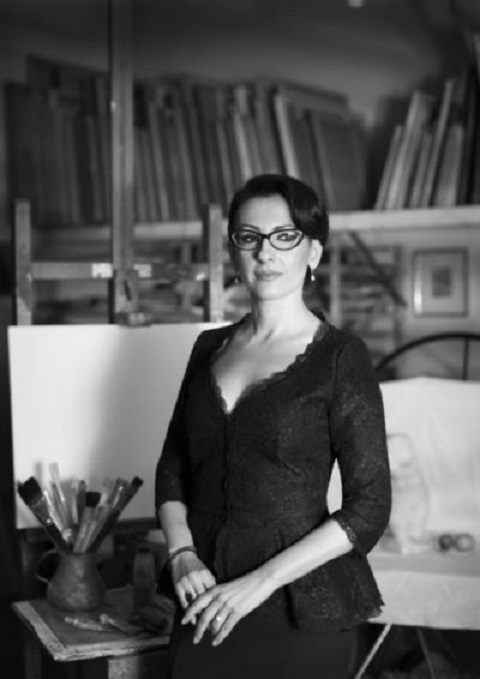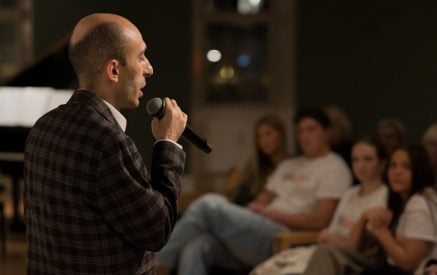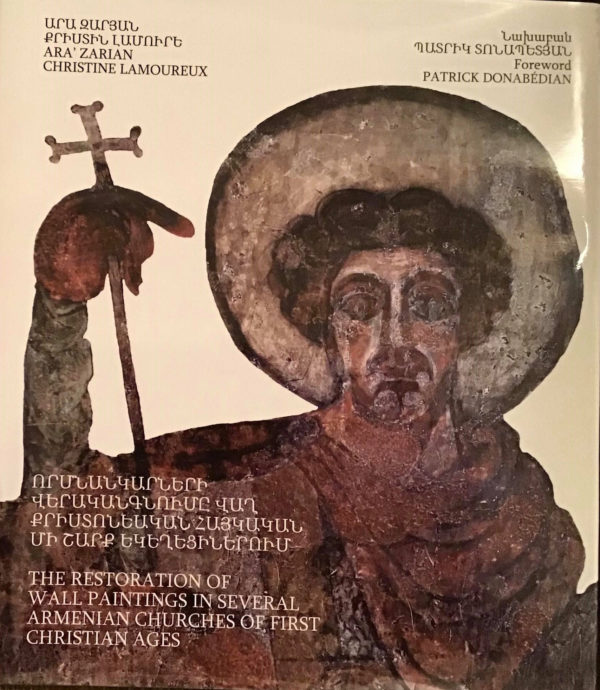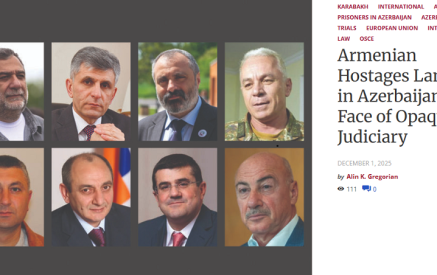MOSCOW/YEREVAN — Lawyer, public figure Gayane Georgyan, was born in Tbilisi and raised in Russia. She is the director of the branch for the CIS and EAEU countries of the Helsinki International Commercial Arbitration. Since 2018, she has been managing the Victoria International Charitable Foundation, founded by her. Over the past two years, the foundation has carried out a number of social and cultural projects in the field of preservation, promotion and restoration of cultural values of world importance. Three books have been published – Dadivank: A Revived Miracle (2018, in Armenian, English, Russian, there is also unpublished French translation), Armenian Frescoes (both are by a group of authors, in Armenian) and The Restoration of Wall Paintings in Several Armenian Churches of First Christian Ages (by Ara Zarian and Christine Lamoureux, in Armenian and English, 2019). Gayane lives between Moscow and Yerevan, she has four daughters and is actively involved in the cultural life of Armenia and the Republic of Artsakh.
Dear Gayane, although you are a lawyer, you initiate Armenian cultural projects. Why is that?
Read also
The main mission of a lawyer is to protect the weak, defend the rights of the disadvantaged and deprived people. Therefore, for me, jurisprudence is directly related to the protection of culture, values of world importance, to which the rich cultural heritage of Armenia, including Artsakh, belongs undoubtedly. I discovered the multifaceted Armenian culture upon my return to my historical homeland. And it was like a journey into a wonderland, where all the beauties and pearls of our centuries-old, unique, unparalleled Armenian culture opened for me door after door.
Artsakh occupies an important place in your charitable pursuits…
When your life, thinking, knowledge are formed in a foreign land, when you grow up in several cultures and when you consider yourself, first of all, a man of the world and a symbiosis of many cultures and traditions, then a moment comes when all this accumulates in you, and you realize that sooner or late you must return your debt to your country and the people. This is your duty, and when they say to me: “Oh, thank you,” I say: “I must be thankful to God and my parents that I was born an Armenian.” And my belonging to my centuries-old culture could not leave me indifferent and ignore the pain and those weak points that we, unfortunately, have. I will frankly say that it was Artsakh and especially the Dadivank Monastery that caused me to have the idea of establishing a fund and two important projects – “Armenian Values in World Heritage” and the unprecedented “Armenian Frescoes an Integral Part of the World Heritage.” This all happened from the period when I set out to find images of St. Nicholas the Wonderworker in Armenian churches. Why exactly was Saint Nicholas interested? This is a common Christian saint revered all over the world, but I noticed the absence of his image in our churches, which was strange for me. As the first Christian country in the world, I was sure that there must be the iconic portrait of this saint somewhere, and it would be something unique. And so it happened. My long search led me to the Dadivank monastery, where Saint Nicholas the Miracleworker appeared in the form of an 800-year-old unique fresco. The first thing I said after the shock of what I saw was: “The world must learn about this!” I decided that this would be a book, myself being a person far from art history or publishing, but at the call of my heart and soul.
And on your initiative, in 2018 the illustrated book Dadivank. Revived Miracle was published, a unique work that comprehensively represents this monument of Armenian architecture and the image of the All-Christian Saint Nicholas the Miracleworker in Armenia. It is interesting that in the 13th century, Princess Arzu built the Dadivank cathedral church, and in the 21st century, another Armenian woman spares no effort to make it known all over the world… Already at that time you were alarming about the endangered state of this masterpiece of architecture, located in the zone risk and raised the issue of its documentation.
You are right, this book is unique. It tells the true story of the creation and prosperity of one of the best monuments of Armenian architecture, about finding Christian relics of world significance and of course, about the unique frescoes of the monastery with the image of St. Nicholas the Miracleworker! But I could just go there as a simple tourist, light a candle, pray and leave, but … the desire to do something more is probably motivated by my heredity. My childhood, the formation of personality and consciousness passed under the talk about the 1915 Genocide, about pain for the lost territories, about pain for the killed relatives and loved ones. My family is patriotic, it went through all the stages of a hundred-year history – my great-grandfather was a warrior, who fought with Andranik, a warrior was also my grandfather, who fought against fascism and had the title of Chevalier of the Order of the Red Star. All my life my ancestors and parents, living in a foreign land, defended their right to be Armenians. And this tradition of being an Armenian, the tradition of preserving my culture and fighting for it, could not leave me indifferent. I knew that sooner or later this mission would come true anyway. When I discovered St. Nicholas, I had the feeling of a man walking through a dense forest or jungle and suddenly finding a beautiful temple unknown to mankind. Dadivank for me was just such a miracle, which was somewhere in the deep mountains, so calm, sort of forgotten at that moment. The fact of finding a common Christian saint in this monastery is still a mystery that I want to solve. It was later that I learned that this ancient monastery in the first century was founded, according to legend, on the site of the death of Dadi, a disciple of the Apostle Thaddeus. Dadivank Monastery was one of the centers of Armenian literature and book-copying. There was a school, four hundred Armenian monks lived and there was the first monastery in the world with a women’s abbey. This fact is even more striking! Women – disadvantaged, humiliated or widows in difficult situations, found their shelter in this monastery. I consider Dadivank in world history to be one of the first, which laid the foundation for feminism. Now everyone is talking about women’s rights, but in Artsakh, already in those days, women’s rights were respected.
Thanks to your efforts in March 2019, children from Artsakh presented the republic for the first time at the international festival.
When I got acquainted through the work on my book with the wonderful country of Artsakh and with the magnificent talented Armenian people, my thoughts haunted, and I jokingly said: “But what can I do with you, you are all so talented!” Really a very noble, courageous people. At that time, I was working on the idea of creating a children’s festival in Artsakh. My good friend Tatyana Shchepatova, the founder of the FaSiLa Moscow Festival, a singing competition in foreign languages, responded to my idea. And as a result, a very interesting format was chosen for Stepanakert – FaSiLa: World Children Against War, a singing competition in foreign languages. Why was it conceived in such an international format (songs were sung in only five foreign languages), was because it was supposed to additionally attract the attention of the world public to Artsakh. The winner of the festival was to perform at one of the best and largest venues in Moscow. Not to mention that in the thirty years of Republic of Artsakh’s existence, for the first time on the Moscow stage, for the first time on the international stage, it was at this festival that children from Artsakh performed on behalf of their country – it was an important diplomatic move. The festival will be continued, we will do this in 2021 and nothing will stop us. I always say that all the projects of the Foundation related to Artsakh and the preservation of the Armenian world cultural Christian heritage will continue.
Everyone, of course, is interested in the funding of your projects.
All funds are sitting in front of you, dear friend (laughing). Funds, of course, are the most painful topic, there are no sponsors, we survive at the expense of our personal savings and the help of friends. I have no idea how long this will be continued. I do my job, launch it into the universe, turn it into energy, and then let everyone decide. I have always loved these words: the way I treat people is my karma, and what they answer me – is theirs.
But nevertheless, I hope you get generous sponsors for your projects.
I always say that I will not work for anyone and I do not like working with intrigues. But I am always open for good people, for partners, for people who are idealistically committed to this work, like me. That is, if someone looks for some kind of benefit for themselves, personal ambitions in these projects, they will not find it. If you are dealing with sacred things, with holy concepts, you must serve them unrequitedly, free of charge.
Gayane, I cannot help but notice that seven years ago, when we started to communicate, our communication was only in Russian, and now you speak fluent Armenian.
This requires two important components. First of all – to have a desire to master the language and ambition to overcome difficulties. The second is to surround yourself with the right literate people and absorb from them like a sponge. All these years I was energized and studied, eagerly absorbing knowledge from the best artists, musicians, public figures. I have always said that one of the first people I met in Yerevan, especially in the field of social and cultural life, was you! Interesting people opened up for me through you, I listened to everyone and eventually listened to them. Now, thank God, I express myself in my native language. You have to talk, read all the time, the main thing is not to be ashamed of expressing yourself. If I don’t know a word, I’m not ashamed to ask how it will be in Armenian. I am never ashamed to ask about something that I do not know.
What is the last book you read in Armenian?
My publications (laughing). I can hardly read them, as well as the materials of the Foundation, which are in Armenian. By the way, it really pulled me up. And so I always knew how to read and write in Armenian. At the age of 12, I took the alphabet of the Armenian language for the first time and started just learning. At the age of 13 I already knew by heart the poems of our poets, for example, “Little Lake” by Bedros Tourian …
After the last national calamity, how do you imagine the continuation of your activities?
People called me and asked me to share my optimism and energy with them. I am not going to give up, I always say that I am not going to shed tears, suffer and grieve for the sake of the Motherland. I even forbid people from thinking that. One hundred years is too much for suffering, and now I force everyone, even order them to work, create for the sake of the Motherland, be optimistic, eventually learn to respect each other, help each other freely, learn to rejoice in each other’s successes. And if you see that one person has a good idea, something useful for the Motherland, help him. Three years ago, I knocked on all doors: governments, international organizations, at all levels, whether in Armenia or abroad. I raised the relevance of what is happening now. The preface to the projects and mission of the Foundation today sounds like a prediction. And then no one even understood what I was talking about. Now I find it funny that all and sundry, regardless of their quality or intelligence, dedication or awareness of the importance of this matter, for the sake of their own PR, raise the topic of preserving cultural heritage. Where have you been before, gentlemen?
And how will surprise us in the near future?
This is again a book, an unprecedented encyclopedia for Armenology – Fortresses of Artsakh by historian and researcher Slava Sargsyan. This is the result of thirty years of work, consists of about 1000 pages, which show more than 100 fortresses of Artsakh that have survived to this day. So far – in Armenian…
























































